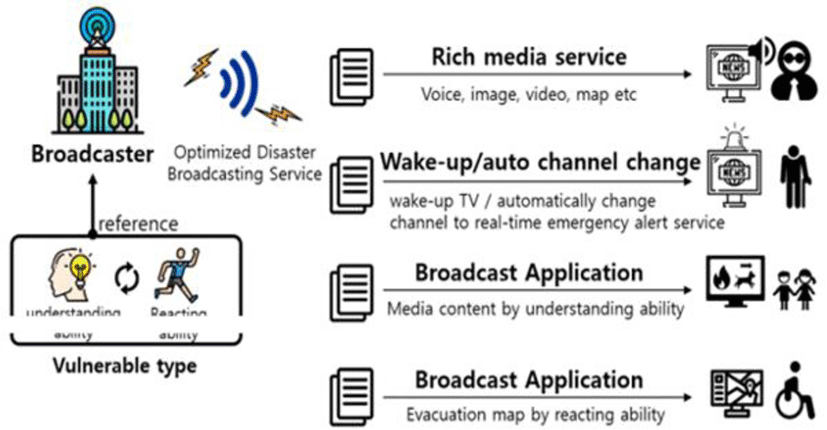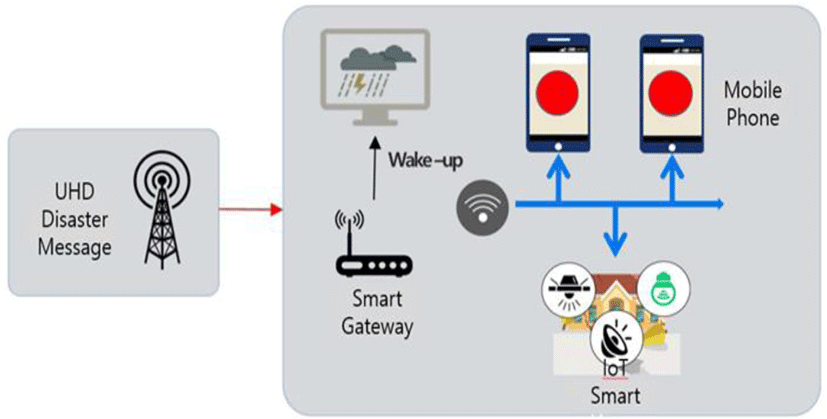I. INTRODUCTION
Recently due to climate change caused by global warming, natural disasters such as heat waves, floods, typhoons, and cold waves have reached a serious level worldwide. A global pandemic such as COVID-19 is also threatening human safety as a new social disaster. Disasters are now becoming commonplace.
Although enormous social and economic costs are being invested to respond to frequent disasters, the vulnerable group such as the disabled, the elderly, children and foreigners are still in a state of overlapping disasters. In addition to the damage caused by the disaster itself, they are facing a dual risk situation due to inability to access disaster information.
According to a survey by the Japan Disabilities Forum, the overall mortality rate in the Miyagi area during the 2011 Great East Japan Earthquake was 0.6%, but the death rate of persons with disabilities was 1.6%, more than doubled [1]. In the case of Korea, the number of casualties per 100,000 people in the fires that occurred between 2010 and 2014 by the Seoul Fire and Disaster Headquarters was 4.7 times higher for people with disabilities than for non-disabled people [2].
As of the end of 2021, there are 2,644,700 persons with disabilities in the blind spot of the disaster information delivery system in Korea, accounting for about 5.1% of the total population, of which 32.8% are hearing and 9.5% are visually impaired [3]. In particular, it is necessary to provide customized information that can promptly check the disaster situation through broadcasting and communication media because the impaired have difficulty in accessing visual or auditory information.
ATSC 3.0, the latest North American next-generation broadcasting standard, includes Ultra High Definition (UHD) service, improved efficiency, IP-based media transmission technology, interworking of companion devices, personalization, and interactive functions [4].
Korea has also been conducting research on disaster warning broadcasting service using UHDTV since 2018, but it is staying on services centered on non-disabled people.
In order for the ATSC 3.0 technology to provide an effective disaster broadcasting service for the impaired, above all, it is necessary to analyze the demand of the impaired for what information and how to obtain in a disaster situation. This study intends to examine the expansion strategies of ATSC 3.0 technology based on in-depth interview data for the visually and hearing impaired.
II. THE CHARACTERISTICS OF ATSC 3.0 BASED DISASTER BROADCASTING SERVICE
UHDTV disaster broadcasting service using ATSC 3.0 ha four advantages [5]. The first is an automatic recognition function and strong reception performance. A wake-up function that can wake the receiver from a standby state and a function that can forcefully switch to a channel that provides disaster information. The wake-up signal is sent to the bootstrap element within the frame. Bootstrap includes sampling frequency, signal bandwidth, time domain structure, etc. for the digital transmission signal.
The second is customized information delivery in consideration of region and language. It provides regional based differentiated disaster information, and it is also possible to provide multilingual services and separate information according to recipient group.
Thirdly, fixed and mobile simultaneous reception is possible, which is an important advantage considering that an emergency alert can be delivered to a receiver on the move, and a personal terminal has a great emergency alert delivery effect. It can also support special-purpose receivers for disaster management organization, electronic signboard, and dedicated receivers for premises broadcasting.
The fourth is the rich media function, which can provide multimedia information such as video, audio, image, and HTML files, and it is easy to deliver detailed information through a broadband network.
Table 1 shows the disaster alert element structure of ATSC 3.0 [6].
III. DEVELOPMENT AND LIMITATIONS
Pointing out that the ATSC 3.0 AEAT (Advanced Emergency informAtion Table) does not specify matters regarding the vulnerable, a study was conducted to classify the vulnerable according to disaster awareness and evacuation ability [6]. Afterwards, as shown in Fig. 1, a customized disaster broadcasting service scenario was presented in consideration of the characteristics of each type of disaster vulnerable. Furthermore, to implement such a scenario, a study was conducted to extend the attribute value of ATSC 3.0 AEAT and add elements.
Although this study can be positively evaluated in that it allows the transmission of necessary information for each type of disaster vulnerable class, it does not solve the need for expansion as it is still limited to information transmission through UHD broadcasting network.
Meanwhile a study conducted by KPEW (Korea Partnership for Emergency Warning) suggested a framework for raising the alarm accessibility problem and deserving a solution to provide mobility convenience for the vulnerable in disasters using ATSC 3.0 [7]. This study is based on the protective action decision model (PADM), which divides the process by which a person perceives threats from the physical environment and socially transmitted information and draws attention in daily activities. In this study, it was derived that vulnerability may occur in alerting, perception, understanding, and behavior during the PADM process when the vulnerable in a disaster receives an alert. And a method for improving user accessibility was suggested using ATSC 3.0.
Recently, ETRI has started developing cloud-based customized disaster information media service platform technology for the underprivileged in disaster information [8]. This research aims to design a cloud-based service and develop platform technology, machine learning-based disaster information media, automatic conversion technology, service standard, and demonstration service.
Summarizing the above studies, it seems that so far, the goal is to develop platforms and services such as customized information production and transmission for the disaster-vulnerable by utilizing the advantages of ATSC 3.0 technology.
However, this study intends to pay attention to the needs to analyze the demand for disaster information of the vulnerable class, especially the visually and hearing impaired in advance, in carrying out such technology development research. This is because efficiency of technology can only be achieved when a detailed analysis of what type of information the beneficiary of the technology wants to acquire and use must be reflected. In the next chapter, we will examine the demand analysis for disaster information based on the data collected through in-depth interviews with the visually and hearing impaired.
IV. ANALYSIS OF DISASTER INFORMATION DEMANDS
In order to analyze the demand for disaster information of the visually and hearing impaired, in-depth interviews were conducted with 4 people for each type of disability.
The main results of the in-depth interview with the visually impaired are as follows.
-
A warning sound must be included at the first point in time of a disaster.
-
Disaster information, which is mostly provided with subtitles, needs a service that can convert it to voice through text-to-sound (TTS). For this, it is necessary to standardize that UHDTV so that the TTS module is installed by default, and the ability to select various modes according to the user’s needs is required.
-
As a disaster information is delivered through multimedia content, the proportion of graphics, photos, and videos is expected to increase. Accessibility that can explain visual materials such as image to sound (ITS) with voice is required.
-
Since some people with low vision can perceive light or color, it is necessary to have the ability to adjust the screen size or select color contrast. It would also be good if it is linked with a smart light bulb that can control light color and brightness.
-
When interconnecting with various IT devices, in-cluding mobile phones or assistive devices, is possible, damage can be minimized during evacuation after a disaster. In particular, since the prevalence of smart watches is high, it will be helpful if it is linked with this. The AI speaker is also a device that is highly utilized by the visually impaired, so there is a need to link it with UHDTV information signal.
-
Since visually impaired people use the radio a lot, it is necessary that UHDTV disaster information is also transmitted through the radio. The small radio receiver is portable, so it can be used while evacuating.
-
Since it is difficult to evacuate in case of a disaster, it is necessary to have a help function that can request help through UHDTV.
-
Because the TV remote control is inconvenient to use for the visually impaired, it would be good if it could be operated through motion or voice recognition.
Then, the main results of the in-depth interview with the hearing impaired are as follows.
-
In order to recognize a disaster for the first time, it is necessary to provide information through light or vibration. Since there are many hearing impaired people who have waring lights at home, it would be good to link with this.
-
The UHDTV wake-up function simply cannot recog-nize that the TV is turned on and broadcasting starts. It should be able to transmit a light or vibration to recognize that the TV is on.
-
A method of sending the wake-up signal to an aroma device in the house and spraying a scent can be considered, because of smell can be transmitted in any situation.
-
Since many middle-aged hearing impaired people have difficulty reading text, the proportion of disaster information through sign language should be increased. Considering that real-time sign language interpretation is difficult by the sign language translator, avatar technology should be actively used.
-
Currently, the sign language interpretation screen is too small in size, so there is a problem in transmitting information through facial expression, so a size adjustment function should be included.
-
In order to evacuate after a disaster, information must be continuously received through a mobile phone or wearable devices, so a linkage technology with UHDTV must be included. In particular, the effect will be great if it is linked with a hearing aid, which is often used by the hearing impaired.
Summarizing the results of in-depth interviews with the visually and hearing impaired, it can be seen that it is essential to link the home-network, IoT, and wearable devices to collect information for initial recognition and evacuation beyond the general demand for disaster broadcasting services. In particular, the method of converting it into olfactory information, such as aroma device, is noteworthy.
V. CONCLUSION AND SUGGESTIONS
The conclusion of this study can be summarized in four points. First, based on demand analysis of the visually and hearing impaired, information transmission through light and vibration should be parallel in the initial recognition process of a disaster, and various in-house IT devices such as UHDTV sets, IoT, wearable devices (smart watch, hearing aid, etc.), warning light should be linked. communication security, reliability, interoperability council (CSRIC) also points that ATSC 3.0 should include smart light and app-based notification system, and local smart home hubs [9].
Fig. 2 shows the frame of the UHDTV disaster alert information interoperability study that ETRI is currently conducting. The UHDTV disaster information signal is linked with various devices and applications through the in-house gateway, and can also be expressed as a signal such as light or vibration [8].
Second point is that disasters don’t just happen when people is inside in home, so it needs to interconnecting technology that can be connected anytime, anywhere, especially outdoor space. So UHDTV disaster information must be connected to public display media, digital signage, kiosk, screens in bus or taxi, etc.
Thirdly, interconnecting with assistive devices used by the visually and hearing impaired will also be highly effective. Recently, the development of communication aids for the visually and hearing impaired has been active, and if these devices are equipped with a function that can transmit and receive disaster information, it will help to minimize disaster damage.
Lastly, there are many challenges to be solved until the solutions that are derived from demand analysis are developed, applied, and experienced in practice. This is because the problem of economic analysis and standardization of technology can be solved when the governance between the government, corporation, and research institutes is working. For example, even in the case of UHDTV service using ATSC 3.0, since it is provided only through direct reception, the percentage of households that can actually use it is very low, about 5% or less. Because it is not compatible with the IPTV or cable TV used by most of the people. Therefore, the law should enable the institutionalization and realization of the results of technological development.



